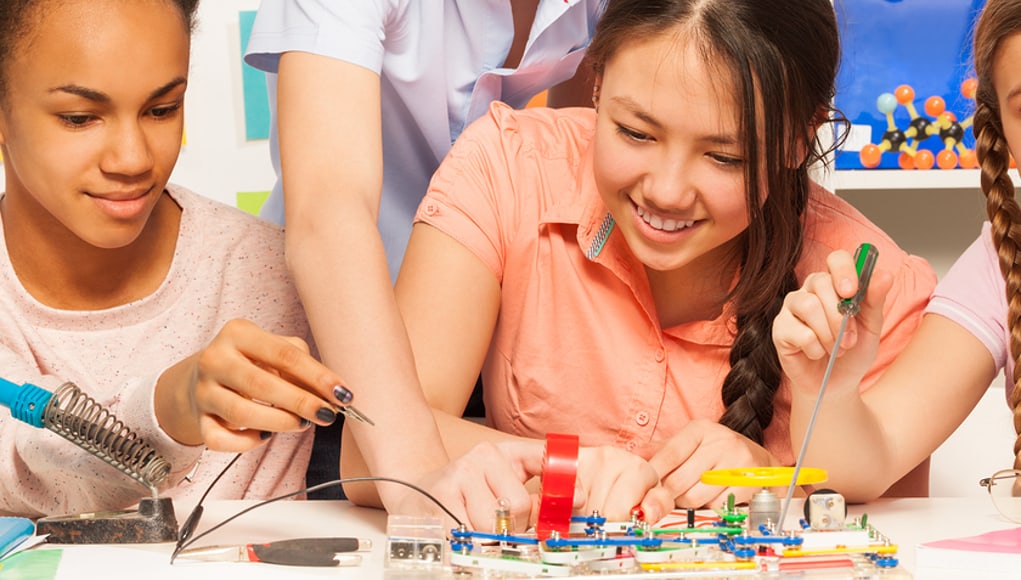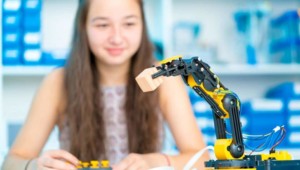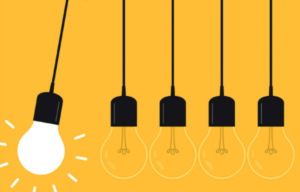Teaching Students How to Bring Their Dreams to Life

By: Piet Grymonprez.
“In 1961, when a new president, just a few months into his term in the White House, challenged America to “land a man on the moon and return him safely to the Earth”, no one in America knew how to make it happen. But that wasn’t going to stop them rising to Kennedy’s dare.
“The young minds (the average age of Apollo 11’s mission control team was 28) who were put to work on Apollo were all recent graduates who had benefited from former president Eisenhower’s National Defence Education Act, a massive capital investment in the US education system, started in the late 50s in response to Sputnik.”
When I read this article by Christopher Riley in The Guardian in 2012, I started thinking that what the members of the Apollo 11 team all had in common was their ability to dream (big) and to work in a context in which the power of possibility was key to shaping minds into solution-driven-thinking. A context that allowed them to be both afraid of the unknown and at the same time to embrace it as a challenge.
If you would have asked the global population at the beginning of the sixties if this assignment if this dream could be brought to life, I think you will agree that probably an overwhelming majority would have said “no”. Fast forward to the early nineties, the result would be the same if we would have asked people about the possibility of taking a picture in Capetown and somebody in Brussels would see it and respond to it within a split second after taking the picture. Nobody at that time had a clue what the internet was and could mean to our everyday life. The inability of the majority of people to think freely and to accept the challenge to create something totally new without squashing the idea up front as ‘impossible’, ‘insane’, ‘ridiculous’ or ‘why bother’, isn’t just a pity, it’s a symptom of a deeper issue of mankind.
When we are between the ages of 4 and 9, we have a strong capacity for ‘having a go’. At that age, we don’t limit ourselves, our thoughts and our dreams. If there’s a problem, young children have a strong capacity of popping up a solution to it. And in many cases, a part of the solution would address the imagination. Playing with his toy cars, my little boy would just argue that the car that is speeding up to an obstacle ahead, would just start flying as a solution to avoid a collision. As we grow up, most of us lose that ability. We become victims of our own knowledge. Our grown-up minds would ramble about the fact that cars can’t fly. So the whole situation with the toy car is an accident waiting to happen.
But what would happen if we set our minds and knowledge to the creation of a car that could fly? When we started, we wouldn’t have a clue of what the end result would look like. That would be something we would gradually build. And just like any result, once you are there, you reflect and conclude that in hindsight the final product is very logical and what you would expect from such a product. Just like the teams that, already more than a decade ago, started thinking about self-driving cars.
What is truly sad about this loss of the ability to embrace ‘the blank sheet of paper’ in front of you – as a canvas for you to make a first drawing of your dream idea -, is that almost no education system on the planet is embracing this creative capacity. Instead, they focus on transmitting knowledge; which is to a certain level, necessary of course. But unfortunately, there’s no room for showing young people how they can actually dream and bring their dreams to life, both by using their knowledge and by accepting unexplored ideas and solutions. In some respects, human beings are different than the rest of life on earth. They include these unmatched powers of creativity and collaboration. Because of them we can step outside our immediate circumstances and imagine alternative ways of being and doing. More than that, we can work to materialize these visions through the varying systems and technologies that we collectively forge. As our children face the daunting challenges of a world that’s spinning faster than ever, these powers of possibility have never been more needed.
MyMachine, a non-profit organization, is helping make it possible for students to answer this innocent, but, as you will find out, deep question:
What is Your Dream Machine?
We asked Matisse, 6, if he could have any ‘dream machine’ what would it be and what would it do? Matisse replied, “Could you please make me a machine that chases away the ghosts from under my bed?” So that’s exactly what we did. It became ‘The Spocker’ – a beautiful robot that gives a status report to Matisse, clarifying what good ghosts will stay and protect him during the night and what bad ghosts have been banned. So now Matisse can go to sleep safe and sound.
It’s quite the journey from inception to inventions like ‘The Spocker’. The MyMachine methodology consists of three steps in one academic year:
- IDEA: Children from Elementary Schools invent their own ‘Dream Machine’. Anything goes. The main criterion is that it’s relevant for the child who really, really wants it.
- CONCEPT: Higher Education Students (e.g. product design students, game design students, engineering students) step in to help out in translating this idea into a product concept.
- WORKING PROTOTYPE: Technical Secondary Schools Students step in to help out in building a real working prototype.

These steps are not divided steps. On the contrary, all students co-create throughout the whole process.
In the end, everything, from drawings, mock-ups to the working prototypes are presented in a please-do-touch exhibition to be discovered by all the children, students and the broad public. After that, each of the working prototypes go back to the concerned elementary school to be on display. Some of the ideas will actually become commercially viable products.
A Revolving Bunk Bed or A Shake-Awake.
MyMachine is working to materialize unexplored dream machine ideas. Like the Revolving Bunk Bed (finally, you don’t have to discuss anymore who gets to sleep on top), or the Homework-Making-Machine, the Anti-Boredom-Machine, The Shake-Awake (a bed that shakes you awake instead of having an alarm clock making a dreadful noise) or The Secretly-Giving-Compliments-To-Each Other-Machine. 
MyMachine has helped youth produced thousands of ideas and hundreds of working prototypes. The students involved with MyMachine get to go through a life-changing experience that enables them to go through and understand the steps it takes to bring an idea to life. They learn that this is only possible by collaborating, by respecting each other’s talents and by accepting the unknown that you can tackle if you collectively focus on solution-driven-thinking.
Emmy, eleven years old, invented a Tent-Umbrella. At school, she was in a temporary classroom while renovations took place. The classroom was far away from the lunch room. Emmy was from an area where it rained–often. So, Emmy wanted an umbrella that could be small when there were a few students at noon going from the classroom to the lunch room, but big enough when a larger group was walking together. The engineering product design students that translated Emmy’s idea into a concept were challenged not to accept the obvious that an umbrella can never be made big enough to be used by twenty-five children at the same time. They took on an opposite view, claiming that an umbrella should not, by definition, be small, foldable, round shaped and carried by a human to be functional. It allowed them to make it work, and they ultimately delivered exactly the functionality Emmy was asking for. But it wasn’t an umbrella at all. It ended up being the shape of an extra-large caterpillar that can extend with the number of children using it.
Inter-Generational Collaboration
In his famous TED-Talk, Sir Ken Robinson explains that education is running a 19th-century model that was built to support industrialism and built in the image of it. Schools are still organized like factories. They run on bells and are organized and separated based on subjects. In the middle of these educational factories runs a narrow-minded intellectual model of the mind. The consequence being that many brilliant people think they’re not because they’ve been judged against this particular view of mind.
MyMachine is creating a free haven in the rigid education system that allows all participants to break free from the rules and start driving their own learning. We clear out the age factor: it is marvelous to see how a young child of 6 or 9 is discussing the design, as peers, with college students. And how this child is then collaborating with a 16-year-old technical secondary school student in making the working prototype. While doing all this, the students work on their 21st-century skills. Hank Nourse, Vice-President of Learning at The New York Academy of Sciences, argues that the value of MyMachine lies in stimulating the disciplines of science, technology, engineering, the arts and mathematics, collectively known as STE(A)M, along with competence in what are commonly referred to as 21st-century, non-cognitive, or social-emotional skills—capacities such as creativity, communication, collaboration, and persistence, which will serve participants for life.
How Students Learn in MyMachine
Students from all levels are collaborating and learning with the help of MyMachine:
 |
Elementary School Children learn that the world in which they live in is malleable and that they can actually contribute to society, rather than just be a consumer of society. They learn that having ideas is important and brings joy and wonder; they learn what it takes to bring an idea to life; and they learn the importance of STE(A)M, entrepreneurialism, respect for others talents, collaboration and co-creation. |
 |
Higher Education Students go through an amazing hands-on experience (with budget restraints and deadlines) that mimic their future jobs. They learn to listen to their customer, in this case, the elementary student; they learn to use their own knowledge and how to translate the idea into a concept while taking into account the production facility they can use. Students learn how to understand what production machines these schools have, what complexity level the participating technical secondary school students can handle. Thus the concept they create needs to fit all these requirements. |
 |
Technical Secondary School Students learn about the valuable contribution they can make in a product design flow. They learn that in many cases they can actually improve the design of the engineers. They learn to communicate about how they see the production could be made easier and better. That is how they understand the importance of their skills as an invaluable asset in the production context. |
Just Take Those Young Children for Serious
Young children in our primary classrooms today, are the future decision makers, engineers, dancers, artists, nurses and pilots. Because of the fact that our human capability of dreaming about something that matters to us and harnessing creativity to come up with brilliant new ideas, is part of our DNA but squashed as we grow up, we need to radically change some parts of our education system.
In our experience with MyMachine we have learned it is key that we take young children seriously. We ask them the question “What is your dream machine?” and we are not, as adults, giving them an assignment to come up with ideas for clean air problems or anything else that we adults think is important. We focus only on what the child feels is important. By doing so, we show them, that their ideas matter. That their ideas are useful. And the mere fact that older students collectively join forces to bring that idea to life is extremely important and extraordinary. For elementary school children, it often feels like ‘finally my older sister or brother is making some time for me and together we’re building something, something that I invented’.
This experience, where adults prove that your ideas matter and actually can be brought to life, will have a lasting impact on you as a child and on society as a whole. Because these children will grow up understanding that all accomplishments are the result of the decision to try and the ability and the will to dream out loud.
MyMachine is Global
Founded in Belgium by Piet Grymonprez (Howest University of Applied Sciences), Jan Despiegelaere (Community Foundation of West-Flanders) and Filip Meuris (Leiedal), the MyMachine Global Foundation has started a franchise system that allows other regions to start-up a MyMachine chapter.
MyMachine is now in eight countries, across three continents (Belgium, Slovenia, Portugal, Slovakia, France, Norway, South Africa and the USA).
Piet Grymonprez is Co-Founder & Managing Director of the MyMachine Global Foundation. You can find Piet and MyMachine on Twitter at @mymachineglobal.
For more, see:
- 3 Elements of Deeper Project-Based Learning
- Gen Z Students Need Schools That Match Their Dream Big Approach
- Defining and Differentiating Personalized Learning, Blended Learning and Competency Education
- Smart Review | Drones in Education: Let Your Students’ Imagination Soar
- Two Key Points for Understanding Imagination in Education
Stay in-the-know with all things EdTech and innovations in learning by signing up to receive the weekly Smart Update. This post includes mentions of a Getting Smart partner. For a full list of partners, affiliate organizations and all other disclosures, please see our Partner page.







Patti Shade
Simply marvelous! It is fabulous to know that our Creativity Crusade is alive and well in other parts of the world! Empowering young minds with the skillsets and mindsets of creativity should be the major goal of education. It’s all about creating classrooms where students “know and feel” they have the FREEDOM TO THINK!